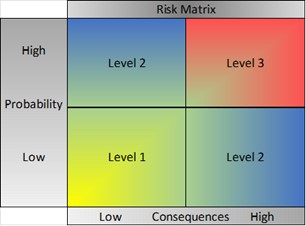The Door Security and Safety Foundation (DSSF), in collaboration with the Door and Hardware Institute (DHI) has formed a task force of experts to recommend levels of security required for building openings, as there are no national standards. The following three levels are intended for public use to help educate and provide advice on specifying and furnishing the necessary attributes of a secure opening on any project. These levels are meant to Deter, Detect, and Delay adversarial behavior to allow time for emergency response personnel.

When associating security levels, consider the probability of risk. When assessing the risk of adversarial behavior at an exterior or interior perimeter opening, it is helpful to be able to quantify the risk by considering both the probability of this event occurring and the potential consequences. This assessment will guide users to the most appropriate mitigation recommendations listed below.
Three Levels of Secure Openings
The security levels provided above are outlined as general in nature to account for all structures or building types as a basis of design for your reference.
Level 1 – Basic level of control and security. (See appendix A)
Openings are flush and may or may not have a visible glass area within the door. They are securely latched, locked, and have some form of controlled or monitored access, either mechanical or electronic. When monitoring is used, monitoring should cover the door position within the opening and the latch position.
Level 2 – Intermediate level of control and security. (See appendix A)
Openings are flush or have a visible glass area within the door. They are securely latched, locked, and have some form of electronic access control and monitored access. At a minimum, monitoring will cover door position within the opening and latch position.
Level 3 – High level of control and security. (See appendix A)
Openings are flush or have a visible glass area within the door. They are securely latched, locked, and swing out. The doors are made of UL-rated construction for bullet resistance with appropriate core material and glazing, if applicable. They have some form of electronic access control and monitored access. At a minimum, monitoring must cover the door position and latch position.
To view the full PDF, please fill out the short form below to gain access to the download link. DHI will not use your email for marketing purposes.
Supported by: